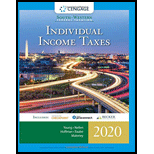
Individual Income Taxes
43rd Edition
ISBN: 9780357109731
Author: Hoffman
Publisher: CENGAGE LEARNING - CONSIGNMENT
expand_more
expand_more
format_list_bulleted
Question
Chapter 19, Problem 1DQ
To determine
Ascertain whether each of the following independent statements is best applied to a defined contribution plan (DCP), a defined benefit plan (DBP), Both (B), or neither (N).
Expert Solution & Answer
Explanation of Solution
Defined contribution plans: In a defined contribution plan, the additions made to an employee’s account annually cannot exceed the lesser;
- “$56,000 (during 2019)”, (or)
- “100 percent of the compensation made by the employees”.
Defined Benefit plans: In a defined benefit plan, the annual benefit paid to an employee is restricted to the lesser of the following;
- “$225,000 (in 2019)” or
- “100% of the average compensation for the highest three years of employment”.
Ascertain whether each of the following independent statements is best applied to a defined contribution plan (DCP), a defined benefit plan (DBP), Both (B), or neither (N).
| Serial Number | Applied to the best of |
| a. | DBP. |
| b. | DCP. |
| c. | DBP. |
| d. | N. |
| e. | DBP. |
| f. | B. |
| g. | N. |
| h. | DCP. |
| i. | DCP. |
| j. | DBP. |
Table (1)
Want to see more full solutions like this?
Subscribe now to access step-by-step solutions to millions of textbook problems written by subject matter experts!
Students have asked these similar questions
I am looking for the correct answer to this financial accounting problem using valid accounting standards.
I am looking for the correct answer to this general accounting problem using valid accounting standards.
Provide correct solution and accounting question
Chapter 19 Solutions
Individual Income Taxes
Ch. 19 - Prob. 1DQCh. 19 - Prob. 2DQCh. 19 - Prob. 3DQCh. 19 - Prob. 4DQCh. 19 - Prob. 5DQCh. 19 - Prob. 6DQCh. 19 - Prob. 7DQCh. 19 - Prob. 8DQCh. 19 - Prob. 9DQCh. 19 - Prob. 10DQ
Ch. 19 - Prob. 11DQCh. 19 - Prob. 12DQCh. 19 - Prob. 13DQCh. 19 - Prob. 14CECh. 19 - Prob. 15CECh. 19 - Prob. 16CECh. 19 - Prob. 17CECh. 19 - Zack, a sole proprietor, has earned income of...Ch. 19 - Prob. 19CECh. 19 - Prob. 20CECh. 19 - Prob. 21CECh. 19 - Prob. 22CECh. 19 - Prob. 23CECh. 19 - Prob. 24CECh. 19 - Prob. 25CECh. 19 - On April 5, 2017, Gustavo was granted an NQSO for...Ch. 19 - Prob. 27PCh. 19 - Prob. 28PCh. 19 - Prob. 29PCh. 19 - Prob. 30PCh. 19 - Prob. 31PCh. 19 - Prob. 32PCh. 19 - Prob. 33PCh. 19 - Prob. 34PCh. 19 - In 2019, Magenta Corporation paid compensation of...Ch. 19 - Prob. 36PCh. 19 - Prob. 37PCh. 19 - Prob. 38PCh. 19 - Prob. 39PCh. 19 - Prob. 40PCh. 19 - Prob. 41PCh. 19 - Prob. 42PCh. 19 - Prob. 43PCh. 19 - Prob. 44PCh. 19 - Carri and Dane, ages 34 and 32, respectively, have...Ch. 19 - Prob. 46PCh. 19 - Prob. 47PCh. 19 - Prob. 48PCh. 19 - Prob. 49PCh. 19 - Prob. 50PCh. 19 - Prob. 51PCh. 19 - Prob. 52PCh. 19 - Prob. 53PCh. 19 - Prob. 54PCh. 19 - Prob. 55PCh. 19 - Prob. 56PCh. 19 - Prob. 57PCh. 19 - Prob. 1RPCh. 19 - Prob. 2RPCh. 19 - Prob. 3RPCh. 19 - Prob. 6RPCh. 19 - Prob. 8RPCh. 19 - Prob. 1CPACh. 19 - Ryan is 39 years old and works as a real estate...Ch. 19 - Prob. 3CPACh. 19 - Prob. 4CPA
Knowledge Booster
Similar questions
- Accountingarrow_forwardmighty Manny, Incorporated manufactures ice scrapers and distributes them across the midwestern United States. Mighty Manny is incorporated and headquartered in Michigan. It has product sales to customers in Illinois, Indiana, Michigan, Minnesota, and Wisconsin. It has sales personnel only in the states discussed and all these states have adopted Wayfair legislation. Determine the state in which Mighty Manny does not have sales and nexus given the following scenarios:arrow_forwardPlease provide the answer to this general accounting question with proper steps.arrow_forward
- Nullarrow_forwardThirst Quencher produced 20,000 cases of powdered drink mix and sold 17,000 cases in April. The sales price was $22 per case, variable costs were $14 per case ($10 manufacturing and $4 selling and administrative), and total fixed costs were $55,000 ($40,000 manufacturing overhead and $15,000 selling and administrative). The company had no beginning Finished Goods Inventory. Requirements1. Prepare the April income statement using absorption costing.Known - OI $87,000 2. Determine the product cost per unit and the total cost of the 3,000 cases in Finished Goods Inventory as of April 30. 3. Is the April 30 balance in Finished Goods Inventory higher or lower than variable costing? Explain why.arrow_forwardDon't use ai given answer financial accountingarrow_forward
arrow_back_ios
SEE MORE QUESTIONS
arrow_forward_ios
Recommended textbooks for you
 Intermediate Accounting: Reporting And AnalysisAccountingISBN:9781337788281Author:James M. Wahlen, Jefferson P. Jones, Donald PagachPublisher:Cengage Learning
Intermediate Accounting: Reporting And AnalysisAccountingISBN:9781337788281Author:James M. Wahlen, Jefferson P. Jones, Donald PagachPublisher:Cengage Learning




Intermediate Accounting: Reporting And Analysis
Accounting
ISBN:9781337788281
Author:James M. Wahlen, Jefferson P. Jones, Donald Pagach
Publisher:Cengage Learning